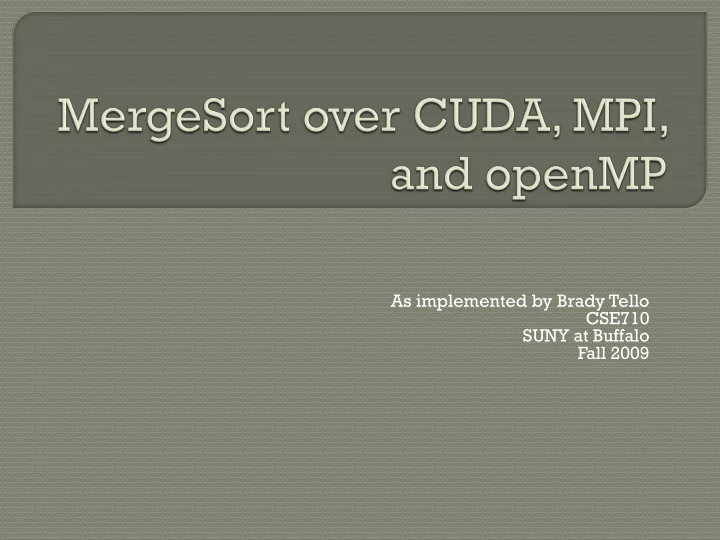

As implemented by Brady Tello CSE710 SUNY at Buffalo Fall 2009
MergeSort review (quick) Parallelization strategy Implementation attempt 1 Mistakes in implementation attempt 1 • What I did to try and correct those mistakes Run time analysis What I learned
Logical flow of Merge Sort
The algorithm is largely composed of two phases which are readily parallelizable Split Phase 1. Join phase 2.
Normally, mergeSort takes log(n) splits to break the list into single elements Using the Magic cluster’s CUDA over OpenMP over MPI setup we should be able to do it in 3.
Data => 1/10 1/10 1/10 1/10 1/10 1/10 1/10 1/10 1/10 1/10 MPI_SEND Dell Nodes For my testing I used 10 of the 13 Dell nodes (for no reason besides 10 is a nice round number) Step 1 is to send 1/10 th of the overall list to each dell node for processing using MPI.
#pragma openmp parallel num_threads(4) initDevice() 1/10 Now on each Dell node, we start up the 4 Tesla co-processors on separate OpenMP threads
cudaMemCpy (…, cudaMe mcpyHostToDevice) 1/10 Now we can send ¼ of the 1/10 th of the original list to each Tesla via cudaMemCpy At this point CUDA threads can access each individual element and thus we can begin merging!
On each Tesla we can merge the data in successive chunks of size 2 i
On each Tesla we can merge the data in successive chunks of size 2 i
On each Tesla we can merge the data in successive chunks of size 2 i
On each Tesla we can merge the data in successive chunks of size 2 i
On each Tesla we can merge the data in successive chunks of size 2 i
Grid My initial plan for doing this merging was to use a single block of threads on each device Initially each thread would be responsible for 2 list items, then 4, then 8, then 16 etc. Since each thread is responsible for more and more each iteration, the number of threads can also be decreased.
Example
Example
Works in theory but CUDA has a limit of 512 threads per block NOTE: This is how I originally implemented the algorithm and this limit caused problems
At this point, the list on each Dell node will consist of 4 sorted lists after CUDA has done it’s work. We just Merge those 4 lists using a sequential Merge function.
1 st merge
2nd merge
final merge
1/10 1/10 1/10 1/10 1/10 1/10 1/10 1/10 1/10 1/10 MPI_SEND 1/10 1/10 1/10 1/10 1/10 1/10 1/10 1/10 1/10 Dell Nodes Now we can send the data from each Dell Node to a single Dell Node which we will call the master node. As this node receives new pieces of merged data, it will just merge it with what it has already using the same previously mentioned sequential merge routine. This is a HUGE bottleneck in the execution time!!!
I tested and implemented this algorithm using small, conveniently sized lists which broke down nicely. Larger datasets caused problems because of all the special cases in the overhead • Spent a lot of time tracking down special cases • Lots of “off by 1” type errors Fixing these bugs made it work perfectly for lists of fairly small sizes
The Tesla coprocessors on the Magic cluster only allow 512 threads per block. HUGE problem for my algorithm. My algorithm isn’t very useful if it can’t ever get to the point where it outperforms the sequential version
If more than 512 threads needed then add another block Our Tesla devices allow for 65535 blocks to be created Using shared memories, should be able to extend the old algorithm to multiple blocks fairly easily
Was able to get all the math for breaking up threads amongst blocks etc. My algorithm now will run with lists that are very large… • But not correctly There is a problem somewhere in my CUDA kernel • Troubleshooting the kernel has proven difficult since we can’t easily run the debugger (that I know of).
The algorithm is correct except for a small error somewhere Works partially for a limited data size All results are an approximation to what they would be if the code was 100% functional
Sequential merge sort run time (ci-xeon-3) 30 25 20 seconds 15 run time 10 5 0 900 4500 9000 45000 90000 450000 900000 45000000 90000000 900000000 list size Running my parallel version using 900,000,000 inputs on 9 nodes took only 10.2 seconds (although its results were incorrect)
This graph shows run time versus the number of Dell nodes which were used to sort a list of 900,000 elements. Each Dell node has 2 Intel Xeon CPUs running at 3.33GHz Each Tesla co-processor has 4 GPUs The effective number of processors used is: #of Dell Nodes*2*4
Less Processors led to better performance!!! Why? • My list sizes are so small that the only element which really impacts performance is the parallelism overhead.
Communication setup eats up a lot of time • cudaGetDeviceCount() Takes 3.7 seconds on average • MPI setup takes 1 second on average Communication itself takes up lot of time. • Sending large amounts of data to/from several nodes to/from a single node using MPI was the biggest bottleneck in the program.
1. Don’t assume a new system will be able to handle a million threads without incident… i.e. read the specs closely. 2. When writing a program which is supposed to sort millions of numbers, test it as such. 3. Unrolling a recurrence relation requires a LOT of overhead. New respect for the elegance of recursion.
Recommend
More recommend